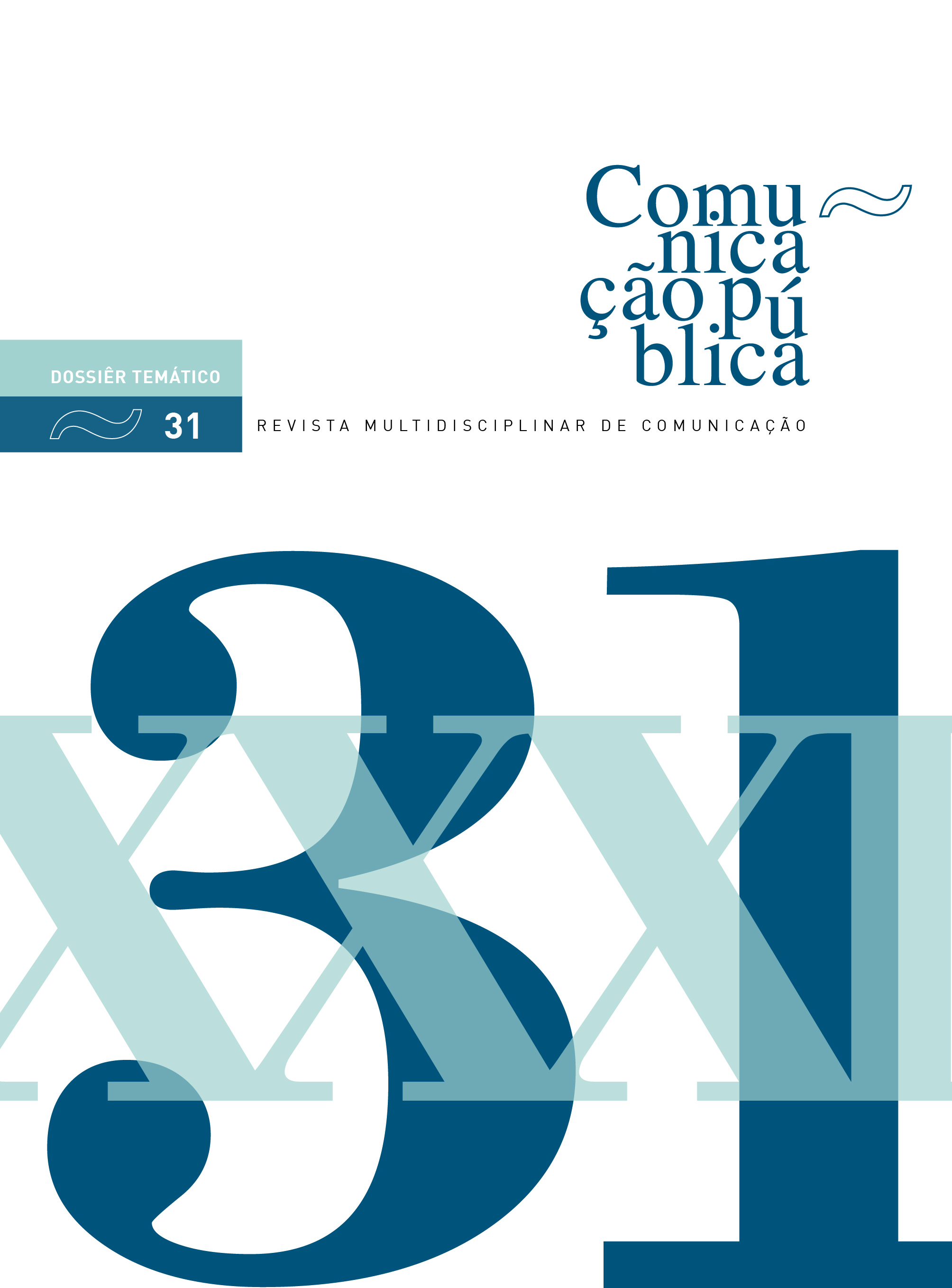Numbers and journalism during the Covid-19 Pandemic
Números e jornalismo durante a Pandemia de Covid-19
DOI:
https://doi.org/10.34629/cpublica.245Keywords:
journalism, numbers, news tones, COVID 19Abstract
This project aims to understand how the pandemic was covered by the media, namely how numerical information served as the basis for the news and its contextualization. We analyzed the news related to the pandemic of three printed newspapers: Público, Diário de Notícias and Expresso. There were some differences between newspapers and that the vast majority of news has a neutral tone. Although the number has an unquestionable media power, numerical information has rarely been used on the newspapers covers or in headlines. On the other hand, when it is used it is usually associated with news that conveys negative or positive feelings.
Downloads
References
Alexandre, I. (2020, 28 de Abril). A covid-19 e o jornalismo guiado por dados. Público https://www.publico.pt/2020/04/28/opiniao/opiniao/covid19-jornalismo-guiado-dados-1914216.
Barros, J. L. e Silvestre, C (2020). Estatísticas e Jornalismo em Tempo de Pandemia. In R. Paulino & C. Rodrigues-Hidalgo (eds.), Jornalismo Sociedade e pandemia (pp. 107-134). Ria Editorial.
Bauer, M. & Schoon, I. (1993). Mapping variety in public understanding of science. Public Understanding of Science, 2(2), 141–155.
Bradshaw, P. (2018). Data Journalism Teaching, Fast and Slow. Asia Pacific Media Educator, 28(1), 55-66.
de Haan, Y., Kruikemeier, S., Lecheler, S. & van der Nat, R. (2017). When Does an Infographic Say More Than a Thousand Words? Journalism Studies, 19(9), 1293-1312.
DGS - Direcção Geral de Saúde (2020). Ponto de Situação Atual em Portugal. https://covid19.min-saude.pt/ponto-de-situacao-atual-em-portugal/.
Dur, B. (2014). Data visualization and infographics in visual communication design education at the age of information. Journal of Arts and Humanities, 3(5), 39–50.
Egan, M., Acharya, A., Sounderajah, V., Xu, Y., Mottershaw, A., Philips, R. Ashrafian, H. & Darzi A. (2021). Evaluating the effect of infographics on public recall, sentiment and willingness to use face masks during the COVID-19 pandemic: a randomised internet-based questionnaire study. BMC Public Health, 21, 367. https://doi.org/10.1186/s12889-021-10356-0.
Fidalgo, A. (2015). A relevância atual da infografia nos jornais Público e The Times [Tese de Mestrado não publicada]. Instituto Politécnico de Tomar.
Garcia, J. L. (2009). Tecnoimagem, iconografia e cultura visual. Estudos Sobre os Jornalistas Portugueses, Metamorfoses e encruzilhadas no limiar do século XXI. Imprensa de Ciências Sociais.
Garcia, R., Rosa M. J., & Barbosa L. (2017). Que número é este? Um guia sobre estatísticas para jornalistas. Fundação Francisco Manuel dos Santos.
Gradim, A. (2000). Manual de Jornalismo Livro de Estilo do Urbi et Orbi. http://www.bocc.ubi.pt.
Guterres, A. (2020). Secretary-General's message 2020. United Nations. https://www.un.org/en/observances/statistics-day/messages.
Hyejin, P., Biddix, P., & Park, H. (2021). Discussion, news information, and research sharing on social media at the onset of Covid-19. Profesional de la información, 30(4), 67-77.
Jacques, E. (2014). Propagandas uma análise estrutural. Antígona.
Lima, R. C. (2015). O que é a infografia jornalística? Revista Brasileira de Design da Informação, 12(1), 111-127.
Link, H. (2021). Information avoidance during health crisis: Predictors of avoiding information about the COVID-19 pandemic among german news consumers. Information Processing & Management, 58, 1-13. https://doi.org/10.1016/j.ipm.2021.102714.
Lopes, R. (2021). News consumption and risk perception of Covid-19 in Spain - Seguimiento informativo y percepción del riesgo ante la Covid-19 en España. Comunicar, 66, 71-8.
Medina, J. L.B. (2020). Géneros jornalísticos: uma questão de género. VIII Simpósio da Pesquisa em Comunicação, Intercom, Sociedade Brasileira de Estudos Interdisciplinares em Comunicação. http://intercom.org.br/papers /viii-sipec/gt05/40-%20Jorge%20Lellis%20-%20trabalho%20completo.htm.
Medina, C. (2020). Apontamentos do Espanto na crise Covid 19. Revista Longeviver II(7), 4-8.
Montejo, G. M., & Adriano, T. Q. (2018). A critical discourse analysis of headlines in online news portals. Journal of Advances in Humanities and Social Sciences, 4(2), 70-83.
Pereira, S. (2015). A Matemática na Imprensa Portuguesa. [Tese de Doutoramento não publicada]. Universidade do Porto.
Pinto, S. (2018). Da impressão interatividade: Usabilidade de infografias impressas e interativas. [Tese de Mestrado não publicada]. IPL - Escola Superior de Comunicação Social.
Serrano, E. (2006). Jornalismo Político em Portugal- A Cobertura de eleições presidenciais na imprensa e na televisão (1976-2001). Edições Colibri/ Instituto Politécnico de Lisboa.
Sjafiie, S. S. L., Hastjarjo, S., Muktiyo, W., & Pawito. (2018). Graphic visualization in printed media: How does the use of technology influence journalism culture. Jurnal Komunikasi: Malaysian Journal of Communication, 34(4), 373-385.
Silvestre C. & Meireles, A. (2021) Learning statistics using infographics: A powerful tool to engage communication students in learning activities. In INTED2021 (ed), 15th International Technology, Education and Development Conference Proceedings (pp. 7074-7081). INTED. https://doi.org/10.21125/inted.2021.
Treadwell G., Ross T., Lee A., & Lowenstein J.K. (2016). A numbers game: Two case studies in teaching data journalism. Journalism and Mass Communication Educator, 71(3), 297-308.
UNESCO 2021 Media and information literate citizens: think critically, click wisely! https://unesdoc.unesco.org/ark:/48223/pf0000377068.
Zamin, A. (2014), Jornalismo de Referência: o conceito por trás da expressão. Revista Famecos: Mídia, Cultura e Tecnologia, 2(3), 918-943.
Downloads
Published
Issue
Section
License
Copyright (c) 2021 Direitos do Autor (c) 2021

This work is licensed under a Creative Commons Attribution-NonCommercial 4.0 International License.
Os conteúdos da Comunicação Pública estão licenciados com uma licença Creative Commons - Atribuição-NãoComercial 4.0 Internacional.


